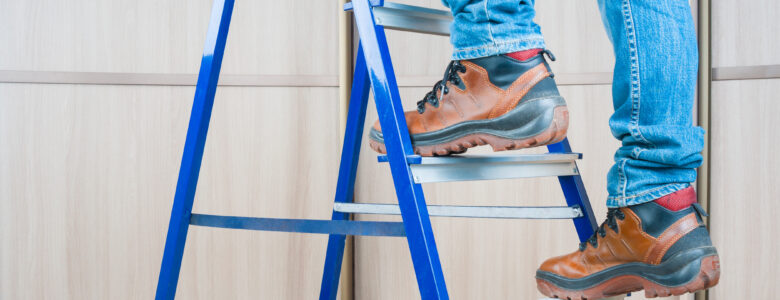According to the Centers for Disease Control and Prevention (CDC), more than 500,000 victims sustain some type of injury each year in the United States because of a ladder accident. Around 300 fatalities occur each year because of ladder accidents as well. The annual estimated cost of ladder injuries exceeds $24 billion each year, with the costs associated with ladder injuries including medical expenses and lost wages, as well as pain and suffering. Some of the serious injuries that are caused by ladder accidents include fractures, brain trauma, and a herniated disc.
Fortunately, you can follow a few tips that can help prevent a ladder accident.
The Importance of Choosing the Right Ladder
Choosing the proper ladder for the project you plan to work on should be the first consideration to help prevent a ladder accident. You need to determine how high a ladder must reach and how much weight a ladder needs to support. Calculating weight is crucial and it requires you to include your weight plus the weight of any work gear and equipment. If you plan to work outdoors, you should consider an orchard ladder (highly specialized ladder engineered for orchard work like pruning, tree training, and fruit harvesting) for gardening and landscaping projects. If you are required to work near potential electrical contacts, you should select a fiberglass ladder.
Establish a Stable Foundation
Regardless of the type of ladder chosen for a project, you have to create a stable foundation to ensure the ladder does not move as you climb and descend from it. The common rule for setting a foundation is to place a straight or extension ladder one foot away from the surface that supports it for every four feet of height. Straight and extension ladders should run three feet above the roof or platform where you plan to work. Make sure to secure an extension ladder with upper support to prevent the ladder from moving. For a step ladder, open it completely and lock the spreaders before getting on the step ladder.
Work with Caution
If your occupation requires you to use a ladder often, do not become complacent just because you have not experienced an accident. Here are a few safety tips to follow when working on a ladder:
Do not use a ladder of any kind if you feel ill or dizzy. Always maintain three points of contact, which means at least two hands and one foot or one hand and two feet are in contact with the rungs. Following the three-point contact standard helps you climb and descend safely from any type of ladder. When you get near the top of a ladder, never climb higher than the third to last rung. Never climb and descend by skipping one or more rungs. If you plan to use tools while on a ladder, secure a tool belt around the waist instead of carrying the tools in one of your hands. Wearing slip-resistant shoes can help prevent a dangerous slip and fall accident.
What Are the Do’s and Don’ts
Knowing what to do and what not to do can help you prevent the injuries that are caused by ladder accidents.
The Do’s
Before every climb on a ladder, perform a thorough inspection to ensure the ladder is in mint condition. An unbalanced ladder or a ladder that is experiencing corrosion should be a red flag that you need a replacement ladder. Do use the three points of contact designed by the manufacturer, which can include steps, hand grips, and traction strips. Keep a ladder free of snow and debris, as well as report any damage that you notice. Do face every ladder you use when climbing and descending. It is highly difficult to reach at least three contact points if your back is against a ladder. Before you get off a ladder, examine the ground to determine whether any gear and equipment is in the way.
The Don’ts
Do not hurry up and down a ladder regardless of the timing of a work project. You should always climb and descend at a slow pace to ensure you follow the three-point contact rule. Jumping off a ladder represents taking a huge physical risk because you might land off-balance, which can cause injuries such as strains, sprains, and fractures. Never allow your belt buckle to move past either side rail, When you move out of the stable zone between the two side rails, you increase the risk of falling off a ladder. Do not work in inclement weather, especially if the bad weather includes nearby lightning strikes.
The Bottom Line
Avoid becoming a ladder accident statistic for the CDC. Follow these basic tips to help prevent ladder accidents.
There for You: Acadia Insurance
At Acadia, we’re all about helping businesses throughout the Northeast thrive. Our mission is to provide superior service and product as close to you as possible, providing you with the backing you need to proceed with confidence.
We understand what you want most from your insurance is security and peace of mind. That means knowing you are backed by an insurance company who will support you every step of the way to help you protect your business.
With Acadia, not only can you get coverage tailored to your needs, but you will also receive support from dedicated claims professionals to guide you through the claim process in the event of a loss. That way, you know exactly what to expect. Knowing your claims professional by name and a hand shake – that’s “Closer Coverage”. Get to know more about how we work and find an agent near you.
Acadia is pleased to share this material for the benefit of its customers. Please note, however, that nothing herein should be construed as either legal advice or the provision of professional consulting services. This material is for informational purposes only, and while reasonable care has been utilized in compiling this information, no warranty or representation is made as to accuracy or completeness. Recipients of this material must utilize their own judgment in implementing sound risk management practices and procedures.




